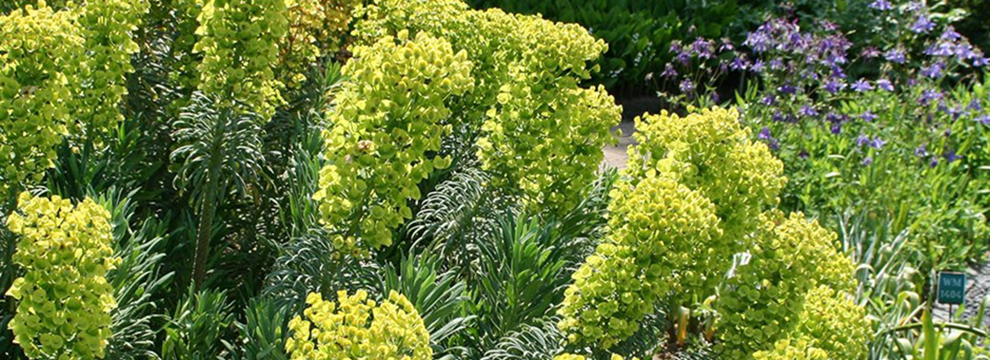Once spring slides into summer the garden is full of fresh foliage, you can almost hear the plants growing, with lots of purple and deep blue flowers from the glorious alliums and moisture-loving irises. These colours look fabulous against the acid yellow euphorbias, it will bring your garden to life and add some dynamic spring zing, so it is not surprising that euphorbias are always found in Chelsea Flower Show gardens. They add that burst of fresh, energetic exuberance which is indispensable at this stage of the year.
Euphorbias make a statement in a border for at least a couple of months because they have a unique flower structure. The acid yellow colour is provided by leathery bracts and colourful leaves, rather than soft petals. The actual flowers are tiny stars, usually pollinated by flies. Once the top growth begins to fade, it’s a good idea to cut most euphorbias back to the ground to promote fresh basal growth, because they can get leggy and this shortens their lifespan.
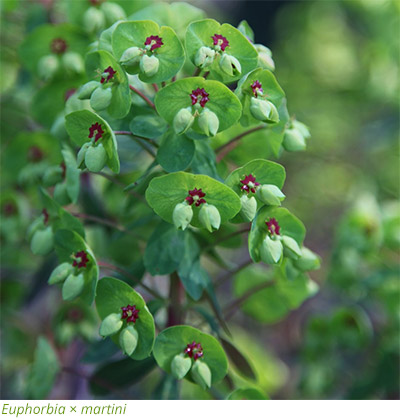 Take Care when Cutting Down Take Care when Cutting Down
Care has to be taken when cutting them down however, because the milky white sap is a serious irritant. It can cause itching and, if it gets into the eyes, it is extremely unpleasant. Always wear clothing that protects your arms and wear safety goggles too, to prevent eye damage. Don’t let this put you off euphorbias though, they’re great garden plants and there’s one for every spot in the garden.
Which One Where
Some euphorbias do very well in shade, particularly those that flower in spring. They can be divided into deciduous plants, ones that die back in winter, and evergreens with year-round foliage.
Deciduous Euphorbias
The earliest to flower is Euphorbia epithymoides, previously called Euphorbia polychroma. This provides a foot-high mound of flower that appears just as the miniature blue bulbs and bluebells appear. The flower heads are 3 to 4 inches across, so it fits into the woodland border really well. It forms a tight clump and doesn’t run about, as some euphorbias do, and it’s extremely hardy. It will continue to look good until the end of June and it’s capable of growing in shade - as long as the soil isn’t too dry.
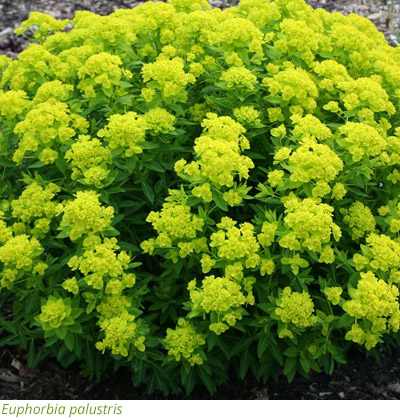 There’s another similar clump-forming, but taller euphorbia that flowers slightly later called Euphorbia palustris. Although this meadow species won’t grow in deep shade, it could be used on the edges of a woodland garden, or a flower border and will be at its best by June. The name palustris indicates a preference for damp ground and one of the common names is swamp spurge. This reaches 3 feet in height and is best staked with some twiggy sticks when it’s a third of its height, because it can blow about. It’s a billowing, rather gentle euphorbia and a good follow-up act to the earlier Euphorbia epithymoides. There’s another similar clump-forming, but taller euphorbia that flowers slightly later called Euphorbia palustris. Although this meadow species won’t grow in deep shade, it could be used on the edges of a woodland garden, or a flower border and will be at its best by June. The name palustris indicates a preference for damp ground and one of the common names is swamp spurge. This reaches 3 feet in height and is best staked with some twiggy sticks when it’s a third of its height, because it can blow about. It’s a billowing, rather gentle euphorbia and a good follow-up act to the earlier Euphorbia epithymoides.
Some euphorbias send up asparagus-like spears in mid-Spring and these tend to spread out and pop up at random in an area, although not invasively so. Euphorbia griffithii ‘Fireglow’ provides a blast of fiery orange-red and it’s very good in dark corners because the flowers stand out well in shade. You could add a late May-flowering tulip such as the almost black ‘Queen of Night’, or the red and yellow ‘Olympic Flame’ as an under planting because ‘Fireglow’ generally reaches 2-3 feet in height. The well-spaced strong stems are also burnished in red, so it’s an architectural plant. It will run about more on lighter soil but is happiest on heavier soil that holds moisture, because this is a Himalayan native used to cool, damp summers. It will also grow in sun.
Another Himalayan euphorbia is Euphorbia cornigera introduced from Kashmir. This tall spurge flowers in July, so it’s often used in autumn borders containing early asters such as Aster × frikartii 'Mönch', because both reach 3ft in height. The attractive bright green foliage has a white midrib and the backs of the leaves are grey, so it’s a good foliage plant. The loose, modestly-sized dome of lime-yellow flowers appear far later than most euphorbias and that makes it useful because they persist and act as a foil among September-flowering asters. The three yellow bracts form a triangular shape, so the whole plant is elegant and sculpted.
Evergreen Euphorbias for Spring Flower
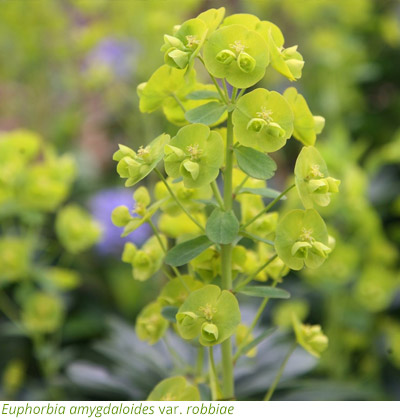 Some euphorbias have attractive winter foliage, although this can become a little ragged in extreme winters. The wood spurge, Euphorbia amygdaloides, is a British native found in deep shade, a position it will tolerate in the garden. There is a purple form with the red foliage named ‘Purpurea’, and the beetroot-coloured foliage flatters the lime-green crosiers especially well. This often flowers in March and looks fresh for a couple of months. Cut it down in May to encourage new growth at the base. This clump-forming euphorbia does have a tendency to self-seed and seedlings appear to come true. It's a real addition to a woodland garden. Some euphorbias have attractive winter foliage, although this can become a little ragged in extreme winters. The wood spurge, Euphorbia amygdaloides, is a British native found in deep shade, a position it will tolerate in the garden. There is a purple form with the red foliage named ‘Purpurea’, and the beetroot-coloured foliage flatters the lime-green crosiers especially well. This often flowers in March and looks fresh for a couple of months. Cut it down in May to encourage new growth at the base. This clump-forming euphorbia does have a tendency to self-seed and seedlings appear to come true. It's a real addition to a woodland garden.
There is another form, Euphorbia amygdaloides var. robbiae, that’s commonly called Mrs Robb's Bonnet. This is a spreader that always travels towards brighter positions, so it’s best grown in wilder areas as ground cover. The foot-high stems have leathery green foliage and the arching head of flowers are a golden yellow. It gets ravaged by cold weather, so try to tuck it into a sheltered corner, but don’t be surprised if it tries to escape!
The curious name reflects its origin. Mrs Mary Anne Robb 1829-1912 was travelling through Turkey in a stage coach when she saw a blaze of gold on the hillside. She stopped the coach and went to investigate and dug up a piece, in an age when this was allowed, and then had nowhere to put it. She made use of her hatbox, hence the name. This plant is extremely good with bluebells because both peak at the same time, so it's a good addition to a garden although you do have to be careful where you put it.
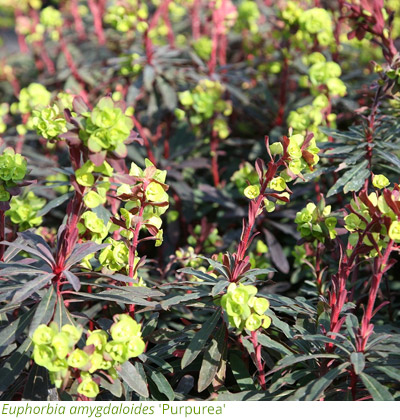 Many euphorbias set seed, although this is rarely a problem in the garden with most of them. Variations do occur and sometimes two adjacent species hybridise naturally and this happened when a natural cross occurred in southern France between a Mediterranean spurge named Euphorbia characias and Euphorbia amygdaloides. The resulting hybrid (Euphorbia x martini), has inherited the grey, felted leaves of Euphorbia characias and the stature of Euphorbia amygdaloides. The so-called ‘flowers’ are lime-green and each little cup surrounds a tiny tomato-red star, so this plant has real eye-appeal. It's extremely good in containers, because it has a sturdy presence, but it's also good in the garden although it does need a slightly sheltered site in bright shade. Plant something with warm-red flowers nearby and this could be a red tulip such as ‘Red Shine’, to bring out that tomato-red star. Many euphorbias set seed, although this is rarely a problem in the garden with most of them. Variations do occur and sometimes two adjacent species hybridise naturally and this happened when a natural cross occurred in southern France between a Mediterranean spurge named Euphorbia characias and Euphorbia amygdaloides. The resulting hybrid (Euphorbia x martini), has inherited the grey, felted leaves of Euphorbia characias and the stature of Euphorbia amygdaloides. The so-called ‘flowers’ are lime-green and each little cup surrounds a tiny tomato-red star, so this plant has real eye-appeal. It's extremely good in containers, because it has a sturdy presence, but it's also good in the garden although it does need a slightly sheltered site in bright shade. Plant something with warm-red flowers nearby and this could be a red tulip such as ‘Red Shine’, to bring out that tomato-red star.
There is a variegated form called ‘Ascot Rainbow’, and the yellow and green foliage is flushed in pink early in the year. This recently got an AGM in the RHS’s euphorbia trial (2013-2015) and I have found it long-lived. It’s best grown in a bright position because it doesn’t develop pink foliage tips in shade. It needs cutting back every year.
A Sunny Spot
Mediterranean euphorbias, like Euphorbia characias, have thick, ribbed stems to resist grazing animals. In the garden these architectural plants make a real statement because their stems billow and curve before unfurling a substantial crosier of acid yellow flowers set above silver-blue foliage. If you have a sunny spot, with good drainage, this spurge will make a real statement for you. The large flower heads almost form cylinders and these last from May until July, at least. Tiny little fruits appear on this plant so many different seedlings have been named. Cut back hard in late summer to promote fresh growth and lengthen the life of your plant. Take cuttings, should you wish, from the new basal growth. They will root easily in gritty compost. The subspecies wulfenii is taller and the golden flowers have a dark eye.
 A Sumptuous Euphorbia for a Sheltered Spot A Sumptuous Euphorbia for a Sheltered Spot
Euphorbias are very varied because this is one of the largest groups of plants, because it’s found all over the world. If you've bought a poinsettia for its colourful bracts, for instance, it's a tender euphorbia from Mexico. Others are more like cacti. Some euphorbias are borderline hardy and Euphorbia mellifera, a native of the Canary Islands, will grow well in British gardens as long as it's grown in a sheltered position. This could be a warm wall against the house, or a very sheltered and sunny border. The foliage is dark green, with a paler midrib, and the flowers, which appear early in the year, have a rich honey scent that carries through the air for some distance. There's a wonderful specimen outside the Botanic Garden at in Birmingham, or there was last time I visited, and I have grown it in my Cotswold garden very successfully. It's a large plant taking up a lot of space, but those early honey-scented flowers are divine. Don't cut this back, it's a tender plant. If you absolutely have to because it's become too large, do it in stages, by reducing a third of it per year.
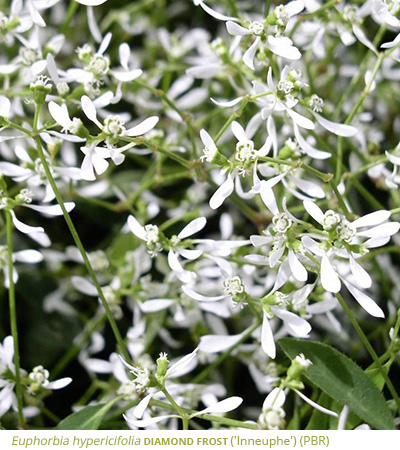 Tender treasure Tender treasure
Euphorbia hypericifolia 'Diamond Frost’ is a delightfully soft plant usually grown as an annual as it is only tender. This is quite a different form from the euphorbias we have spoken about so far in this article. Clouds of small white, 'airy-fairy' flowers appear from late spring through to early autumn, but the narrow leaves and slender form make it great for foliage in patio pots and hanging baskets even before the froth of flowers appear.
|



